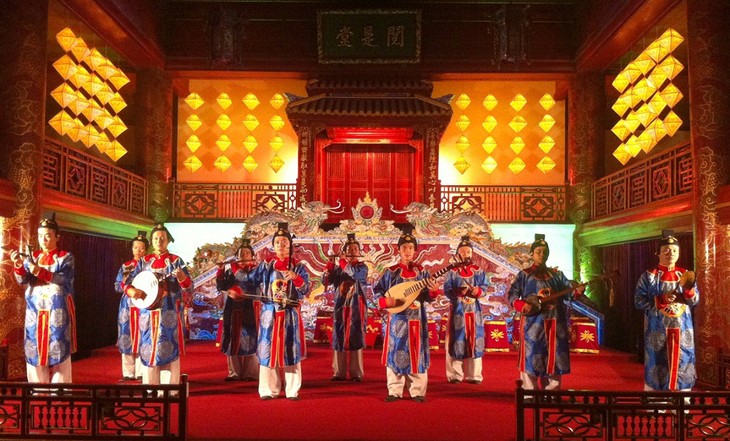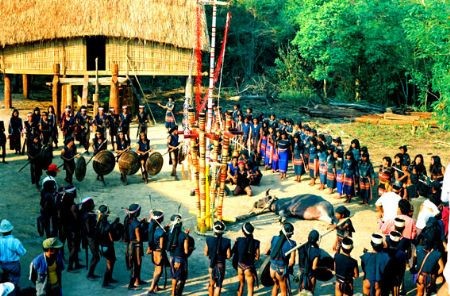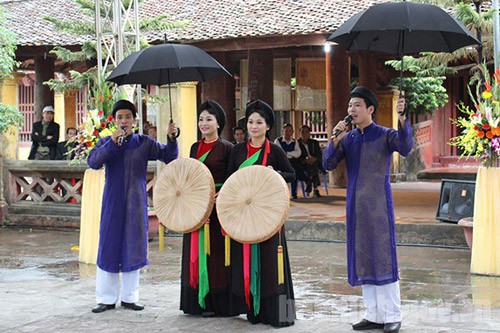A: We’d like to welcome back to VOV Héctor Frías Jofré of Chile who resumed listening to our broadcast on April 20 at 16:00 UTC on the frequency of 7315 khz. In his email to VOV this week, he wrote: “The music was perfect, wonderful and the tourist program was very interesting to listen to.”
B: Thanks a lot for tuning in to our broadcast after more than 2 years. We’ll confirm your report with our QSL card and send you our frequency list and program schedule.
A: This week Dalmani Rachid of Algeria sent us a detailed reception report for the programs from April 13 to 16 on the frequency of 7280 khz saying he loves VOV and Vietnam.
 UNESCO has recognized the sitting tug-of-war games and rituals at Tran Vu temple on the outskirts of Hanoi as part of the Representative List of the Intangible Cultural Heritage. UNESCO has recognized the sitting tug-of-war games and rituals at Tran Vu temple on the outskirts of Hanoi as part of the Representative List of the Intangible Cultural Heritage. |
B: Listening to our story about UNESCO recognition of tug-of-war games, SB Sharma of India wrote: “Congratulation on getting the tug-of-war games and rituals at Tran Vu temple recognized by UNESCO as an Intangible Cultural Heritage. It is great news that tug-of-war is considered an international culture and game. This folk game takes place every year in different parts of Vietnam to show people’s respect for deities and express their wishes for a peaceful future. This game is similar to an Indian game of rope pulling. Two teams pull a rope in opposite directions. The team that pulls the opposite team to its own side wins. It is a friendly match that promotes peace and unity.”
A: It’s great to know that in India you have a game similar to the tug-of-war game in Vietnam.
B: Like SB Sharma, many listeners in India and Bangladesh shared their interest in Vietnamese folk games, songs, and customs which have been recognized as UNESCO Intangible Cultural Heritages.
A: Vietnam has had several intangible cultural heritages recognized by UNESCO. On today’s Letter Box, we will mention some of them.
 Performance of Nha Nhac or Royal Court Music Performance of Nha Nhac or Royal Court Music |
A: In 2008 Nha Nhac or royal court music was inscribed on the Representative List of the Intangible Cultural Heritage of Humanity, Nha Nhac, which means “elegant music” refers to a broad range of musical and dance styles performed at the Vietnamese royal court from the 15th to the mid-20th century.
B: Nha Nhac was generally performed at the opening and closing of ceremonies associated with anniversaries, religious holidays, coronations, funerals and official receptions. Among the numerous musical genres that developed in Vietnam, only Nha Nhac can claim a nationwide scope and strong links with the traditions of other East Asian countries.
A: Nha Nhac performances formerly featured numerous singers, dancers and musicians dressed in sumptuous costumes. Large-scale orchestras included a prominent drum section and many other types of percussion instruments as well as a variety of wind and string instruments.
B: All performers had to maintain a high level of concentration since they were expected to follow each step of the ritual meticulously. Nha Nhac developed during the Le dynasty (1427-1788) and became highly institutionalised and codified under the Nguyen monarchs (1802-1945).
A: A symbol of the dynasty’s power and longevity, Nha Nhac became an essential part of the court’s ceremonies. However, the role of Nha Nhac was not limited to musical accompaniment for court rituals: it also provided a means of communicating with and paying tribute to the gods and kings as well as transmitting knowledge about nature and the universe. Certain forms of Nha Nhac have been maintained in popular rituals and religious ceremonies and serve as a source of inspiration for contemporary Vietnamese music.
 The cultural space of gongs in the Central Highlands of Vietnam is closely linked to the daily life of the local people. The cultural space of gongs in the Central Highlands of Vietnam is closely linked to the daily life of the local people. |
B: The space of gong culture was inscribed in 2008 on the Representative List of the Intangible Cultural Heritage of Humanity. The cultural space of gongs in the Central Highlands of Vietnam is closely linked to the daily life of the local people. Their belief systems form a mystical world in which the gongs produce a privileged language between men, divinities and the supernatural world.
A: Behind every gong hides a god or goddess. Every family possesses at least one gong, which indicates the family’s wealth, authority and prestige. While a variety of brass instruments are used in various ceremonies, the gong alone is present in all the rituals of community life.
B: Each instrumentalist carries a gong measuring between 25 and 80 cm in diameter. From three to twelve gongs are played by the village ensembles. Different arrangements and rhythms are adapted to the context of the ceremony. For example, a ritual sacrifice of bullocks, the blessing of the rice, or mourning rites.
 Performance of Quan Ho folk duets Performance of Quan Ho folk duets |
A: Inscribed in 2009 on the Representative List of the Intangible Cultural Heritage of Humanity, Quan ho folk songs are performed as alternating verses between two women from one village who sing in harmony, and two men from another village who respond with similar melodies, but with different lyrics.
B: The song lyrics express people’s emotional states of longing and sadness upon separation and the happiness of the meeting of lovers. Quan ho singing is common at rituals, festivals, competitions and informal gatherings, where guests perform a variety of verses for their hosts before singing farewell. Younger musicians of both sexes may practice the four singing techniques – restrained, resonant, ringing and staccato – at parties organised around singing.
A: Quan ho songs demonstrate the spirit, philosophy and local identity of the communities in this region, and help forge social bonds within and between villages that share a cherished cultural practice.
B: Quan Ho folk songs, Gong music, and Nha Nhac royal court music are only three of Vietnam’s 12 UNESCO-recognized intangible cultural heritages. We will describe other heritages in later shows.
A: Writing to VOV this week, Shyamal Kumar Banerjee of India reported that there was no signal for our English program on the frequency of 7220 khz on April 20. We have forwarded his report to our technicians. Thank you, Shyamal, for sending the report. We hope to receive continued feedback from you.
B: Next, we’d like to acknowledge emails and letters from Bhaikan Hazarika of India, Abdur Razzak of the Sarak International Radio Listeners’ Club of Bangladesh, M Saleem Akhtar Chadhar of the Seven Stars Radio Listeners’ Club of Pakistan, Siddhartha Bhattacharjee of the Chaitak Listeners’ Club of India, and Konstantin Pravotorov of Ukraine.
A: We’ll send you all QSL cards to confirm your reports. We welcome your feedback at English Service, VOVWorld, Voice of Vietnam, 45 Ba Trieu Street, Hanoi, Vietnam. Our email address is englishsection@vov.org.vn. Thank you for listening to VOV on shortwave and following us online. Goodbye until next time.